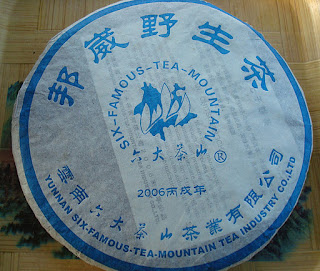
Every pour of this tea has been very saponic. On some infusions the liquor almost looked like jelly with long lasting bubbles. I get excited when puer behaves this way as it often indicates a satisfying, nourishing and delicious tea.

Unfortunately this tea did not deliver for me. I did find a bit of complexity as the tea soup entered my mouth but it was mainly on the tip of my tongue and quickly faded out, leaving behind a flat, boring liquor and bitter aftertaste. Nice flavors such as citrus rind, vanilla and pine were overtaken by harsh flavors like tobacco smoke and an occasional mustiness that reminded me of a wet towel. I'm sure those undesirable flavors did not come from my storage because all of my puer tea is kept on the same bookshelf behind a curtain in my bedroom and none of my other cakes have those flavors.
I can't be too sure what the value of this cake is today and I'll bet there are some folks who would appreciate the tobacco notes but for me, I suppose, I got what I paid for. I've come a long way in my puer tea collecting since 2006 and if I had a time machine I'd go back to 2006 and tell myself to save my ten dollars.
I can't be too sure what the value of this cake is today and I'll bet there are some folks who would appreciate the tobacco notes but for me, I suppose, I got what I paid for. I've come a long way in my puer tea collecting since 2006 and if I had a time machine I'd go back to 2006 and tell myself to save my ten dollars.


















